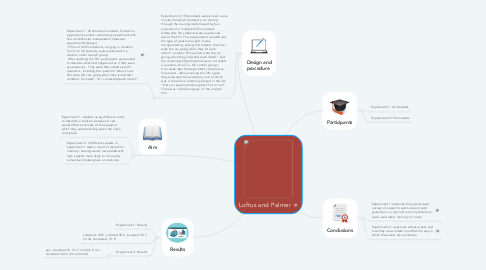Loftus and Palmer
by Pheonix Hamilton palmer


1. Aim
1.1. Experiment 1: whether using different verbs to describe a collision between 2 cars would affect estimates of the speed at which they were travelling when the crash took place
1.2. Experiment 2: if different speeds in experiment 1 were a result of distortion memory- hearing words associated with high speeds more likely to incorrectly remember broken glass at crash site.
2. Design and procedure
2.1. Experiment 2: 150 students were shown a one minute film which featured a car driving through the countryside followed by four seconds of a multiple traffic accident. Afterwards the students were questioned about the film. The independent variable was the type of question asked. It was manipulated by asking 50 students 'how fast were the car going when they hit each other?', another 50 'how fast were the car going when they smashed each other?', and the remaining 50 participants were not asked a question at all (i.e. the control group). One week later the dependent variable was measured - without seeing the film again they answered ten questions, one of which was a critical one randomly placed in the list: “Did you see any broken glass? Yes or no?" There was no broken glass on the original film.
2.1.1. Experiment 1: 45 American students formed an opportunity sample. Laboratory experiment with five conditions(an independent measures experimental design). 7 films of traffic accidents, ranging in duration from 5 to 30 seconds, were presented in a random order to each group. After watching the film participants were asked to describe what had happened as if they were eyewitnesses. They were then asked specific questions, including the question “About how fast were the cars going when they (smashed / collided / bumped / hit / contacted) each other?”
3. Results
3.1. Experiment 1: Results
3.2. smashed- 40.5, collided 39.3, bumped 38.1, hit 34, contacted, 31.8
3.3. Experiment 2: Results
3.3.1. yes- smashed 16, hit 7, control, 6 no- smashed 34 hit 43 control 44

